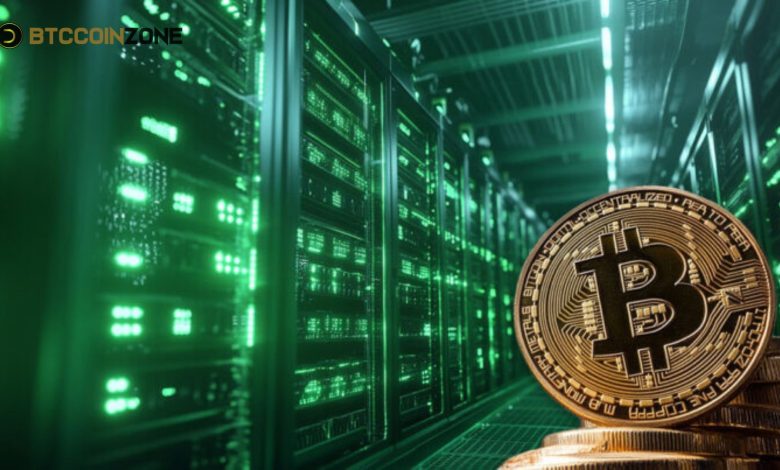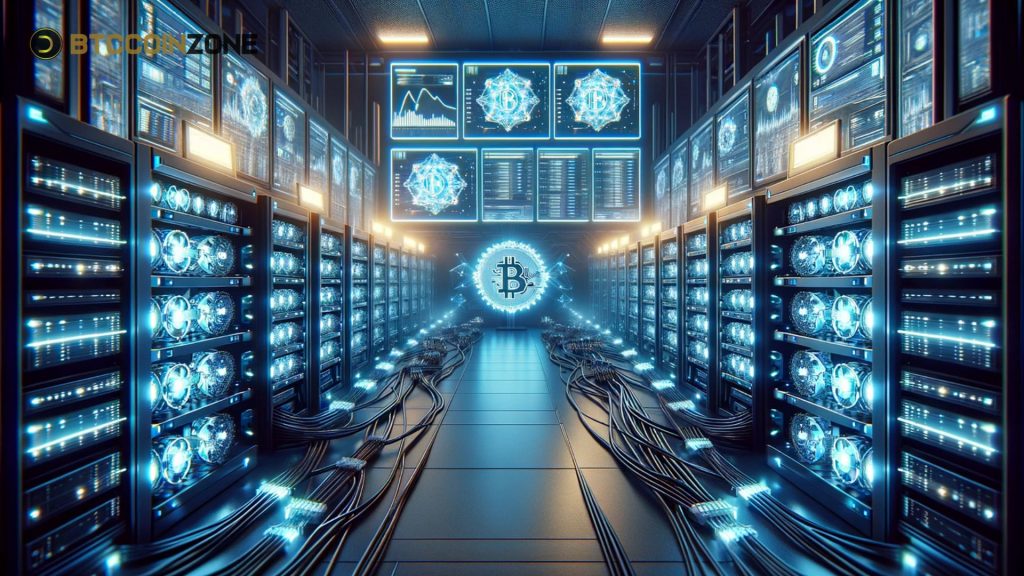Bitcoin Mining Data Centers: Core of Cryptocurrency Ecosyste

Mining Bitcoins has gone from being a small-scale pastime to a massive industry. Big data centers that mine Bitcoin are in the middle of this evolution. These centers solve complicated mathematical problems to verify transactions and keep the Bitcoin network secure. With the processing power they supply, these data centers support Bitcoin’s decentralized architecture and ensure the blockchain’s integrity. This article examines Bitcoin mining data centers in detail, covering their architecture, operations, difficulties, and potential for the future.
Bitcoin Mining Fundamentals
Before learning about mining data centers, you must understand Bitcoin mining. The blockchain, a distributed ledger, records Bitcoin transactions, and mining creates new Bitcoins. The first miner to solve increasingly complex cryptographic riddles adds the following block to the blockchain and receives newly minted bitcoins.

As the network’s user base grew and puzzles became more complicated, miners switched to more powerful GPUs and ASICs. These mining-only machines have much higher processing power than market-available equipment. Bitcoin mining data centres house thousands of supercomputers to fulfil the rising processing power demand.
Bitcoin mining data centre?
Mining data centres house stylish Bitcoin mining hardware in purpose-built facilities. Thousands of ASIC miners toil away at cryptographic puzzles around the clock in these enormous data centres. Since electricity is a significant expense in Bitcoin mining, a mining data centre’s primary objective is to optimise processing power while minimising costs.
- Power Infrastructure: Mining Bitcoin requires enormous amounts of electricity, making power infrastructure a critical element of any data centre. These facilities are typically located in regions where electricity is cheap and abundant, often near hydroelectric dams or other sources of renewable energy. The power infrastructure must be capable of delivering consistent and reliable electricity to thousands of high-powered machines.
- Cooling Systems: The sheer volume of mining hardware generates a tremendous amount of heat. Adequate cooling is essential to ensure that the machines operate efficiently and do not overheat, which could lead to downtime or damage. Data centres that mine Bitcoin use a wide range of cooling technologies, from the tried-and-true HVAC system to more cutting-edge approaches like immersion cooling and liquid cooling, which submerge equipment in a specific fluid that distributes heat more efficiently.
- Networking and Connectivity: Mining data centres must be connected to the global Bitcoin network, requiring robust and reliable internet connections. High-speed networking ensures that the mining operation can quickly receive new puzzles and broadcast solved blocks to the network. For cyberattack protection and downtime reduction, redundant internet connections and secure networking protocols are put to use.
- Security: Given the value of the assets involved, security is a top priority for Bitcoin mining data centres. Physical security measures, such as surveillance cameras, access control systems, and secure perimeters, protect the facility from unauthorised access. Additionally, cybersecurity measures are crucial to safeguard the data centre against hacking attempts and other digital threats.
- Scalability: Bitcoin mining is a competitive industry, and as the network difficulty increases, data centres must scale up their operations to remain profitable. This requires the ability to add more hardware, expand power capacity, and enhance cooling systems without disrupting ongoing operations. Scalable mining data centres use modular structures for progressive development.
Bitcoin Mining Data Centre Environmental Impact
Bitcoin mining’s environmental impact is controversial. Some argue Bitcoin uses more energy than countries, and many are upset. Because mining data centres demand plenty of power. Bitcoin mining’s environmental impact depends on the electricity used by the data centre. Mining communities with coal and other fossil fuels have enormous carbon footprints. However, more mining companies are using solar, wind, and hydropower to reduce their environmental impact. Canada and Iceland, with abundant hydroelectric and geothermal power, have built massive mining data centres.
A growing trend in the mining industry is to build energy-efficient equipment and find creative solutions, such as tapping into renewable energy sources for surplus or connecting mining operations to power grids to balance supply and demand. Together, we can reduce Bitcoin mining’s environmental impact and safeguard its future.
Bitcoin Mining Data Centre Challenges
Despite their importance to the cryptocurrency economy, Bitcoin mining data centres encounter several formidable obstacles:
- Energy Costs and Availability: The profitability of a Bitcoin mining operation is heavily influenced by energy costs. As mining difficulty increases, so does the energy consumption required to solve each puzzle. Data centres located in regions with rising energy costs or limited availability may struggle to remain profitable. Additionally, mining operations can strain local power grids, leading to conflicts with communities and regulators.
- Regulatory Uncertainty: Different countries and regions regulate Bitcoin mining differently. Some countries have encouraged Bitcoin mining with incentives and favourable legislation, while others have banned it owing to energy and financial concerns. Mining data centres face regulatory ambiguity when it comes to long-term investments and operational reliability.
- Technological Obsolescence: The rapid pace of innovation in mining hardware means that equipment can quickly become outdated. Data centres must continuously invest in the latest ASIC miners to remain competitive, which can be a significant financial burden. As more efficient technology is developed, older computers become less profitable, pushing data centres to upgrade or risk falling behind.
- Market Volatility: The profitability of Bitcoin mining is directly tied to the price of Bitcoin. Market volatility can lead to significant fluctuations in mining revenue, making it difficult for data centres to plan and manage their operations effectively. During periods of low Bitcoin prices, mining may become unprofitable, leading some data centres to shut down or scale back operations.
Bitcoin Mining Data Centre Future
Despite all the obstacles, there are a few bright spots for Bitcoin mining data centres in the future:

- Increased Use of Renewable Energy: As the industry faces growing scrutiny over its environmental impact, there is likely to be a continued shift towards renewable energy sources. This not only helps reduce the carbon footprint of mining operations but also provides a more stable and predictable energy supply, which is crucial for long-term profitability.
- Technological Advancements: Ongoing innovation in mining hardware and cooling technologies will likely lead to more efficient and cost-effective data centres. For example, the development of quantum computing and other advanced technologies could eventually revolutionise the mining process, making it more accessible and less energy-intensive.
- Decentralisation of Mining: As Bitcoin mining becomes more competitive and industrialised, a few massive data centres may control mining power. To foster decentralisation, smaller, more efficient mining devices for individuals and small businesses are being built. This could help ensure that the Bitcoin network remains decentralised and resilient.
- Integration with Energy Grids: Some innovative projects are exploring the potential for integrating Bitcoin mining operations with renewable energy grids. By using excess energy generated during periods of low demand, mining data centres can help stabilise the grid while reducing their energy costs. This symbiotic relationship could provide a sustainable model for future mining operations.
In Summary
The cryptocurrency ecosystem relies on Bitcoin mining data centres for network protection and transaction processing. Although the sector is moving toward sustainability and innovation, many facilities’ energy and environmental impacts have not been taken up. Bitcoin mining data centres must adapt to changing legislation, technology, and market trends as the sector grows. Data centres must use renewable energy, improve efficiency, and explore new decentralisation models to maintain their importance in Bitcoin and the cryptocurrency ecosystem.
FAQs
1. What is a Bitcoin mining data centre?
A Bitcoin mining data centre is a large facility housing thousands of ASIC miners that solve cryptographic puzzles to verify transactions and earn new Bitcoins.
2. Why do mining data centres consume so much electricity?
They require immense computing power to process Bitcoin transactions, and powering and cooling these machines around the clock demands massive energy.
3. How do mining centres impact the environment?
If powered by fossil fuels, they can have a high carbon footprint, but many are shifting to renewable sources like hydro, wind, or solar energy to reduce their impact.
4. What challenges do Bitcoin mining data centres face?
Significant issues include high energy costs, regulatory uncertainty, fast hardware obsolescence, and the volatility of Bitcoin prices.
5. What is the future outlook for Bitcoin mining centres?
The future includes increased use of renewable energy, better efficiency through tech advancements, grid integration, and a push toward decentralised mining.




